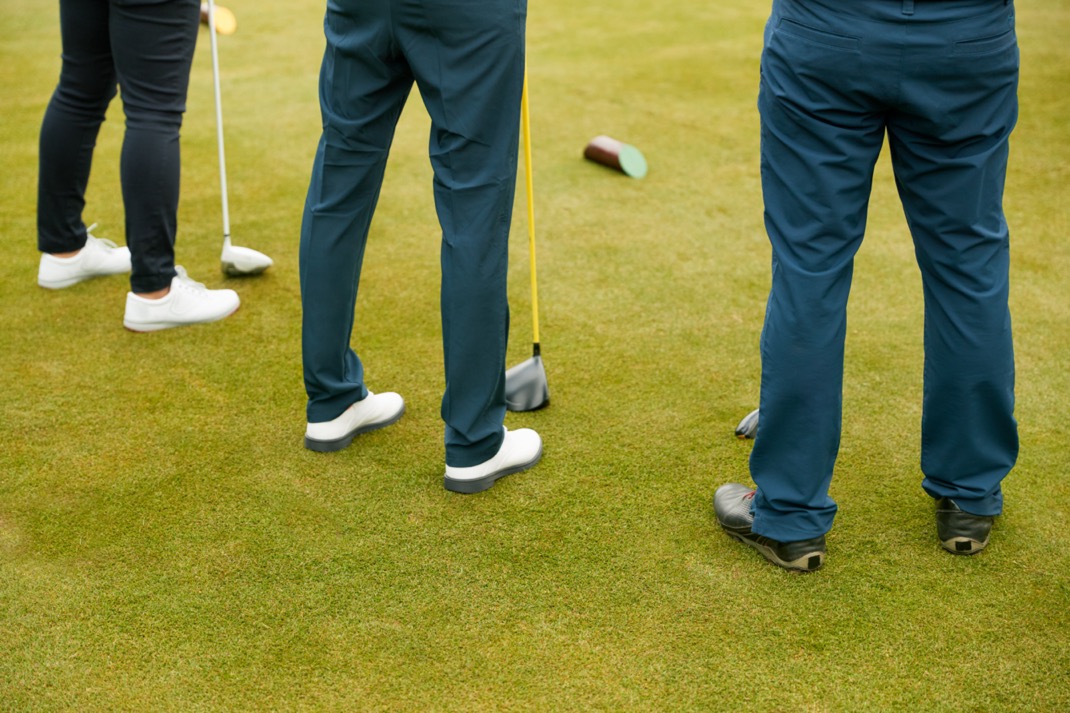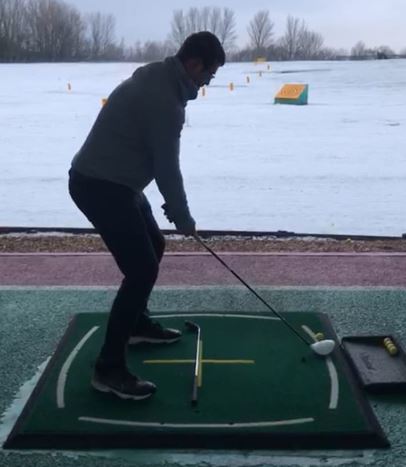Is Golf Hard To Learn – Step By Step Guide To Getting Started

As said by Arnold Palmer, golf is the greatest game mankind has ever invented, and I concur with the seven-time major champion.
However, before you can enjoy the game, there is much research and practice to do. In this post, I explain whether golf is hard to learn.
I will take you through the difficulties that mere mortals face when swinging a golf club and the steps you can take to improve your fortunes. Plus, I introduce you to the importance of mental and physical aspects of golf which impact your performance.
So Is Golf Hard To Play?
In my experience, golf is hard to play and requires time to understand swing mechanics, equipment setups, rules, and etiquette.
A study by Global Odds found that men in the United States stand a 1 in 51,346 chance of becoming a top-tier golfer.
In addition, they found that female golfers stateside have a 1 in 117,286 chance of reaching the peak of golf handicaps.
The USGA suggests the average handicap of male golfers in the US is 14.2, while ladies average 27.5. In Layman’s terms, 14.2 is a mid-handicap golfer. They card the odd birdie and several pars every round and break 90 comfortably.
In addition, a 27.5 handicap average for women places them in the high handicapper category. As a result, the average female golfer exceeds 100 strokes per round.
What should a beginner know about golf?

If you plan on taking up golf, you must prepare for the costs, commitment, and patience required. Golf demands time and money if you are to enjoy the sport and improve your performance over time.
For desirable results, you require the optimal golf equipment, coaching, regular practice, and a mind that is built of steel. Besides the external elements of golf, it is a huge mental game that requires patience and the ability to shrug off mistakes and move on to the next shot.
In What Ways Is Golf Difficult?
Mental
Golf requires a calm temperament and the ability to brush off a bad shot and bounce back. In my junior years, I would often “beat myself up” over a poor strike and ruin an encouraging round instantly. As I matured, I learned patience and astute decision-making were as necessary as my swing.
One event that stands out was the Monthly Mug tournament when I was 14. My handicap was 13, and I was sitting 8 over par with 2 holes to play. I made a double on the par 3 17th, walked onto the 18th in a foul mood, and proceeded to double bogey the 18th.
I finished the event with a gross score of 12 over par and a net of 1 under my handicap, which was good enough for 2nd place in the B division. I lost by 1 shot, and if I had composed myself and boxed smart, I should have easily made a par, which would have seen me win by one shot.
Physical
My non-golfing friends and family always mock me over my love for golf because they say it involves restricted physical exercise. Now, the appearance of some golfers would suggest they are correct. For optimal results, you need to be in peak physical condition.
Padraig Harrington and Vijay Singh are prime examples of the levels you can reach when in peak shape. The two veterans won 6 Major tournaments and still compete on the PGA Tour Champions.
Besides reaching the levels of a low-handicap golfer, you must remain in shape to swing your club, rotate your hips and turn your shoulders. If you struggle in these areas, the game becomes frustrating and hard to enjoy your day on the golf course.
Repetition
A good golfer can transfer what they learn on the driving range to the golf course and repeat the process. The more you practice a specific shot, the better your muscle memory becomes, allowing you to induce the same swing more often than not.
In addition, you must be confident to frequently produce the desired shot for greater consistency. Golfers who lack confidence struggle to focus on the task and execute poorly.
For example, you chunk or shank your shot instead of squaring the face at impact and launching it high and long.
Can you teach yourself to play golf?

Yes, you can teach yourself to play golf, but it typically takes longer to see improvements than if you learn from a coach. Lee Trevino famously said, I’ve never had a coach in my life. When I find one who can beat me, then I’ll listen.”
Well, we are not all Mr. Trevino.I recommend investing in lessons to learn swing mechanics, etiquette, rules, and suitable equipment for your game.
However, I know naturally gifted sportsmen and women who did teach themselves and saw their handicaps lower faster than most. These golfers are few and far between, and most were gifted with exceptional hand-eye coordination.
How long does it take to learn to play golf well?
You cannot put an exact number on the length of time it takes to learn to play golf well. It varies depending on the player. In my experience, I started playing when I was 4 and won and placed in a few junior club competitions when I was 9.
I feel I did not grasp the intricacies of the game until I reached a 4 handicap in my mid-teenage years. Therefore, in my case, it took ten years to learn to play golf well.
What’s The Best Way To Learn Golf Step By Step

Learn About How The Game Is Played?
I suggest talking to your golfing buddies to receive a brief overview of the game to see if it is a sport you will enjoy. Next, source newcomer books to learn about the layout of a golf course, terminology, and etiquette.
If golf still interests you at this time, start reading the R&A and USGA golf rules to prepare for any occasion on the golf course.
Learn About The Swing And Its Mechanics
Once you understand how the game works and how you are expected to conduct yourself, zone in on swing mechanics. I suggest reading Ben Hogan’s Five Lessons to equip you with elementary knowledge in this department.
There are a wealth of blogs and YouTube videos tackling the topic of swing mechanics. However, I find beginners respond best to the advice of a golf coach rather than trying to understand the complexities alone.
A coach will identify your most prominent challenges and provide solutions to improve them. For example, they encourage an inside-out swing path and square clubface at impact.
Learn About The Different Clubs And Their Components
The golf equipment industry is saturated with clubs, grips, and balls for every golfer. You must understand the optimal specifications for your swing for better results on the golf course and recognize how your clubhead, shaft, and grip impact your game.
Your golf coach will guide you to a certain extent, but worth visiting a club fitter for your first rodeo.
They will set you up on a golf simulator and extract data relating to your clubhead speed, club path, launch angle, spin rate, ball velocity, and distance. They then analyze the details and find the correct shaft, clubhead design, loft, and weight for your swing.
Learn About Loft and Distance
Your next mission is to understand the loft each club should be in and how that impacts your spin, launch, and carry distance. Slower swing speed beginners often produce greater distance consistency with weaker lofted clubs because of the added launch assistance.
For example, a beginner is better off hitting a 12-degree driver than a 9-degree setup. The weaker construction gets your ball airborne easily to produce consistent carry distance.
In addition, the higher the loft of your club, the more elevated your launch and the less distance you produce. Therefore, a 12-degree driver travels significantly further than a 25-degree 6-iron.
Visit The Driving Range
Now that you understand the game better and carry the correct equipment, you must frequently visit the driving range and the putting green. This provides a conducive environment to loosen up and test your equipment.
This is the place to make mistakes and learn more about your swing. It also provides a platform for you to take your time and not be judged by other experienced golfers.
Get A Lesson
Many amateurs skip lessons, which is detrimental to their development. Once you have your equipment and a better understanding of the game, book multiple golf lessons with a PGA-certified coach at your local golf course.
These experts will rapidly identify your struggles and send you on the correct path toward improving your golf game. Without the advice of an experienced hand, you may make unnecessary mistakes that you would have avoided if you had visited a coach.
Work On The Lesson At The Driving Range
Golf lessons are one part of the puzzle and are ineffective when you do not put them into practice. Take the advice provided by your coach and employ it on the driving range in your free time, as if you were doing homework.
This enables you to determine whether you are executing your lessons correctly or if there is still homework for you.
Play Pitch And Putt Or Par 3’s
Pitch and Putt or Par 3 golf courses are fun for beginners to get used to the golf game in a relaxed environment. In addition, it gives you a clearer understanding of the importance of your short game in golf.
Furthermore, the shorter forms of golf offer a more budget-friendly approach to playing the game than a complete 18-hole layout.
When Comfortable With Your Swing – Play A Round
Once you have built up the confidence and your swing has taken shape, the next step is to play a round of golf on a complete 18-hole layout. This is where golf becomes fun, and your challenge of lowering your handicap begins.
Practice Practice Practice Consistently
Now that you have the basics behind you, it is imperative to frequently practice every aspect of your game. Golf is not like riding a bike. You can easily forget how to hit a ball if you neglect the training.
I stopped playing golf for three years at one point, and when I returned to the links without practice, I looked like a true hacker.
Keep Track Of Your Score And Try To Break 100
Some golfers play the game because they are happy to be out in nature and hanging out with their buddies. However, many of us have a personal goal to lower our handicaps and become semi-decent golfers.
I recommend keeping the score of every round you play and work towards breaking milestone scores. Start with shooting under 100, then 90, and if you are good enough, 80.
What is the best Age to learn golf?

I suggest learning golf as early as possible because it is a game that you can enjoy your entire life. My childhood buddies and I all started at 4 years old, and I feel this is the best time to take up the game.
What Age is too old?
If you can swing, rotate your hips and turn your shoulders, you are never too old for golf. If you feel too old for the game, I recommend reading The 100-Year Golfer by Ilchi Lee, which shows that your years are just a number in golf.
Can You Play Golf Solo? Is It Better?
Yes, you can play golf solo, and some players prefer it because they can focus on their game without distractions. It is not as fun as a round with your friends and eliminates the camaraderie aspect of the game.
Conclusion
At the start of this post, I set out to answer the question: is golf hard to learn? In my 28 years on the links, I have discovered it is an understatement. Golf demands a solid mental state, a fluid golf swing, physical fitness, and acute shot planning to achieve success.
In addition, it requires the precise club head design, loft, shaft flex, and length to optimize your performance. Playing with the wrong equipment and producing erratic swings with lackluster planning creates a challenging and stressful time.
The solution is to receive lessons from a certified coach, get fitted for the ideal equipment, and practice consistently. Finally, transfer your training onto the course and play as often as possible to build your experience.



